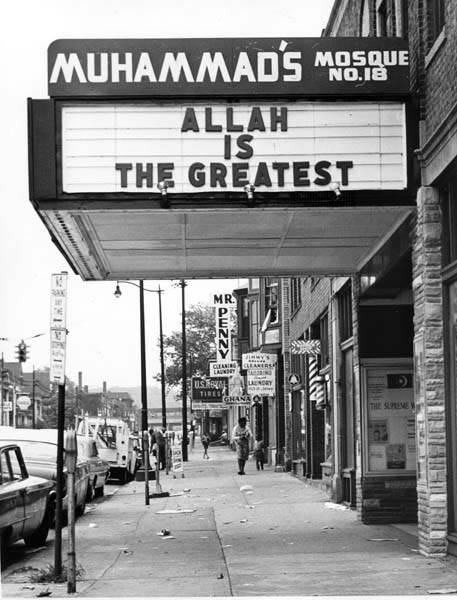Masjid Bilal

A brick building stands askew from the right-angled corner of Euclid Avenue and East 75th Street. This building is the Cleveland mosque Masjid Bilal, which was built to face Mecca in Saudi Arabia. Masjid Bilal takes its name from the Arabic word for mosque–masjid–and Bilal, who was the first African believed to follow the prophet Muhammad more than a thousand years ago. This mosque was the first in Cleveland to be built “from the ground up.” Masjid Bilal was also the first Muslim place of worship to be built in the United States by a predominantly African American congregation.
Originally called Muhammad’s Temple of Islam #18, the congregation worshiped in the old Ambassador Theater at 12416 Superior Avenue. The Cleveland congregation then relocated to a former Roman Catholic Church on East 92nd Street and Holton Avenue. It was at this location that the congregation changed their name to Masjid Willie Muhammad. Construction on a new mosque on Euclid Avenue began in 1982, so the the congregation sold its converted church building to a Baptist group. The only other U.S. mosque built around that time was the Islamic Community Center of Tempe in Arizona. Much of the $500,000 construction of Masjid Bilal was completed by the 1,000 members of the congregation. The 82 x 82-foot building was constructed of a light brown brick and is topped with a golden dome made out of aluminum. This dome is called the prayer tower where the congregation prays five times during each day.
Masjid Bilal was the vision of Imam Warith Deen Mohammed, the son of the Nation of Islam leader Elijah Muhammad. Elijah Muhammad founded the Nation of Islam in Detroit, Michigan, in 1931 to improve conditions for African Americans and people in the United States. Elijah Muhammad did not condone Black Muslims meeting or praying with white people. The Cleveland group was established in the 1950s and adhered to this policy.
When Elijah passed away in 1975, Imam Warith Deen Mohammed succeeded his father. Masjid Bilal was built on land that was purchased and donated by Jabir Muhammad, the director and founder of the nonprofit Muhammad Islamic Foundation. Jabir Muhammad was not only the brother of Imam Warith Deen Mohammed and the son of Elijah Muhammad, but also the manager for Muhammad Ali's boxing career from 1966 to 1981.
Imam Warith Deen Mohammed's vision for Masjid Bilal was completed by Imam Clyde Rahman, the congregation's spiritual leader. After serving and surviving being shot in the head during the Korean War in the 1950s, Rahman became a Detroit policeman and a Nation of Islam minister. Rahman was the Imam for temples in Dayton, St. Louis, Kansas City, Baltimore, and Springfield, Ohio, before settling in Cleveland in 1976. Imam Clyde Rahman spoke to the congregation about unifying across religions to promote peace. When Imam Warith Deen Mohammed removed the racial strictures, Black Muslims changed their name to the American Muslim Mission and began accepting white members.
Masjid Bilal opened "debt-free" and without a mortgage on Friday, June 3, 1983, the Muslim holy day. The first service in Masjid Bilal was the Sabbath prayers, followed by an open house for the public. This began the first of three days of Muslim ceremonies. The mosque had an all-day meeting of national imams, or clergymen, and a dedication banquet at Swingos in the Statler on Saturday. Sunday concluded the festivities with a service. Imam Warith Deen Mohammed attended and led the dedication ceremonies. Masjid Bilal was the first mosque to host annual Ramadan sessions under Imam W. Deen Mohammed.
As a proponent of peace, Masjid Bilal was the location for the second service during the Interfaith Peacekeeping Service on June 9, 1991. Masjid Bilal sponsored a banquet between the three faiths to honor then Cleveland Mayor Michael R. White in 1993. The banquet was held at Swingo's at the Statler, exactly where the dedication ceremony was held for Masjid Bilal ten years prior. This was the first time in Cleveland that all three faiths met together at the behest of a religious congregation. 1993 saw another first when Imam Clyde Rahman said prayers of peace at Temple Ner Tamid on Yom Kippur, the Jewish Day of Atonement. Then in 1994 the spiritual leader of Temple Ner Tamid, Rabbi Bruce Abrams, visited Masjid Bilal to pray during the end of Ramadan, the holy month of fasting. In 2009, Masjid Bilal's original spiritual leader, Imam Clyde Rahman, died at the age of 79. Thanks to his vision, Masjid Bilal welcomes Christians, Jews, and Muslims to pray with them and learn about the Muslim religion and its people. Masjid Bilal has been an essential force in dismantling the barriers between Islam, Judaism, and Christianity.
Images








